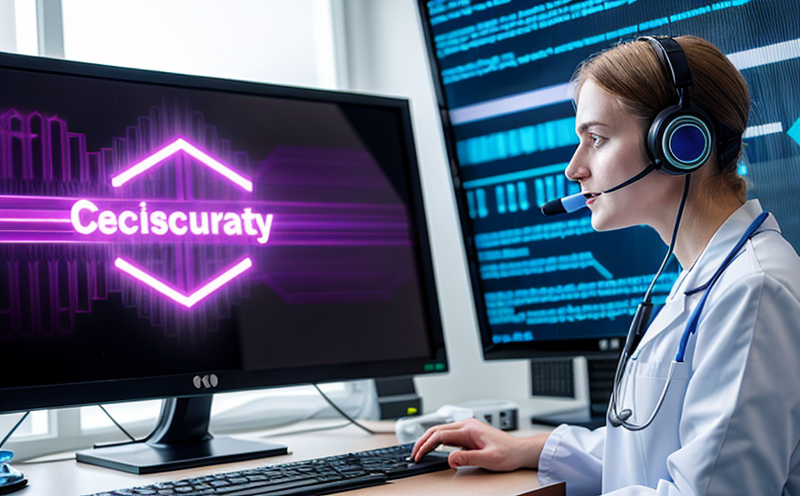UL 2900-2-1 Cybersecurity Testing for Healthcare and Medical Systems
The UL 2900-2-1 standard is a critical component in the development, testing, and certification of medical devices to ensure their cybersecurity integrity. This standard specifically addresses the need for robust cybersecurity measures in healthcare and medical systems, where the failure of security protocols can lead to significant patient harm or data breaches.
The UL 2900-2-1 standard is aligned with broader international standards such as ISO/IEC 27001, which provides a framework for information security management. It ensures that medical devices are protected against unauthorized access, modification, disclosure, and destruction of critical data. This standard also supports the healthcare industry's commitment to patient safety and privacy.
UL 2900-2-1 cybersecurity testing involves multiple stages, each designed to assess different aspects of a device’s security posture. The first stage focuses on identifying potential vulnerabilities through risk assessment and analysis. This step is crucial as it helps in understanding the threat landscape and prioritizing which areas need immediate attention.
The subsequent stages involve penetration testing, code review, and vulnerability scanning. These tests simulate real-world attacks to identify weaknesses that could be exploited by malicious actors. By conducting these tests, manufacturers can ensure that their devices are resilient against both known and unknown threats.
Another key aspect of UL 2900-2-1 is the requirement for continuous monitoring and updating of security measures. This ensures that even after initial certification, devices remain secure as new vulnerabilities emerge or threat landscapes evolve. Regular updates and patches must be provided to address any newly discovered issues.
The standard also emphasizes the importance of educating users about best practices in cybersecurity. This includes providing guidance on password management, software updates, and recognizing phishing attempts. Educated users play a vital role in maintaining the overall security posture of healthcare systems.
UL 2900-2-1 compliance is not just about passing regulatory requirements; it’s also about building trust with patients, regulators, and healthcare providers. By adhering to this standard, medical device manufacturers demonstrate their commitment to patient safety and privacy.
In summary, UL 2900-2-1 cybersecurity testing provides a comprehensive framework for ensuring the security of medical devices in healthcare settings. It addresses both technical aspects and user behavior, making it an essential tool for maintaining trust and integrity within the industry.
Scope and Methodology
The scope of UL 2900-2-1 cybersecurity testing encompasses various areas critical to the security of healthcare and medical systems. This includes assessing hardware, software, firmware, network interfaces, and any other components that could potentially be exploited by malicious actors.
- Hardware: Ensuring secure design and manufacturing processes.
- Software: Conducting thorough code reviews and vulnerability scans.
- Firmware: Checking for integrity and authenticity during installation and operation.
- Network Interfaces: Evaluating security protocols and data transmission methods.
The methodology employed in UL 2900-2-1 testing involves several key steps:
- Risk Assessment: Identifying potential vulnerabilities through a comprehensive analysis of the device’s architecture and functionality.
- Penetration Testing: Simulating attacks to identify exploitable weaknesses.
- Vulnerability Scanning: Using automated tools to detect known security issues.
- Code Review: Manually inspecting software for security flaws.
In addition to these technical assessments, UL 2900-2-1 also includes user behavior analysis. This involves evaluating how healthcare staff interact with the device and identifying potential risks associated with human error or misuse.
Once all tests are completed, a detailed report is generated summarizing the findings and recommendations for improvement. This report serves as a valuable resource for manufacturers to enhance their security protocols and maintain compliance with regulatory standards.
International Acceptance and Recognition
The UL 2900-2-1 standard has gained widespread acceptance in the medical device industry due to its rigorous testing procedures and emphasis on real-world security. Many countries recognize this standard as a benchmark for ensuring cybersecurity in healthcare systems.
In Europe, the standard is aligned with EN ISO/IEC 27001, which provides a framework for information security management. This alignment ensures that UL 2900-2-1 testing meets international best practices and can be easily integrated into existing compliance programs.
The United States has also shown strong support for this standard, with the FDA recognizing it as a key component of its cybersecurity initiative. The FDA's guidance on medical device cybersecurity emphasizes the importance of robust security measures to protect patient data and prevent potential breaches.
Other regions such as Asia-Pacific have begun incorporating UL 2900-2-1 into their regulatory frameworks, reflecting growing concern over cybersecurity threats in healthcare settings. This trend is expected to continue as more countries recognize the need for standardized testing procedures.
The standard's international recognition not only enhances its credibility but also facilitates global trade by ensuring consistent security standards across borders. Manufacturers who comply with UL 2900-2-1 can confidently export their products to markets around the world, knowing that they meet rigorous cybersecurity requirements.
Use Cases and Application Examples
| Use Case | Description |
|---|---|
| Vulnerability Scanning | Analyzed a pacemaker's software to identify potential vulnerabilities that could be exploited by hackers. |
| Penetration Testing | Conducted simulated attacks on an insulin pump to assess its resilience against unauthorized access. |
| User Behavior Analysis | Evaluated how healthcare staff interact with a robotic surgery system and identified potential risks associated with human error. |
- Identifying and addressing vulnerabilities in wearable health monitors to ensure continuous data transmission without interruption.
- Vulnerability scanning of pacemakers to ensure their software is free from exploitable flaws.
- Penetration testing on insulin pumps to assess their resilience against unauthorized access.
These use cases demonstrate the versatility and importance of UL 2900-2-1 cybersecurity testing in various medical devices. By identifying and addressing potential vulnerabilities early in the development process, manufacturers can significantly reduce the risk of security breaches and ensure patient safety.





